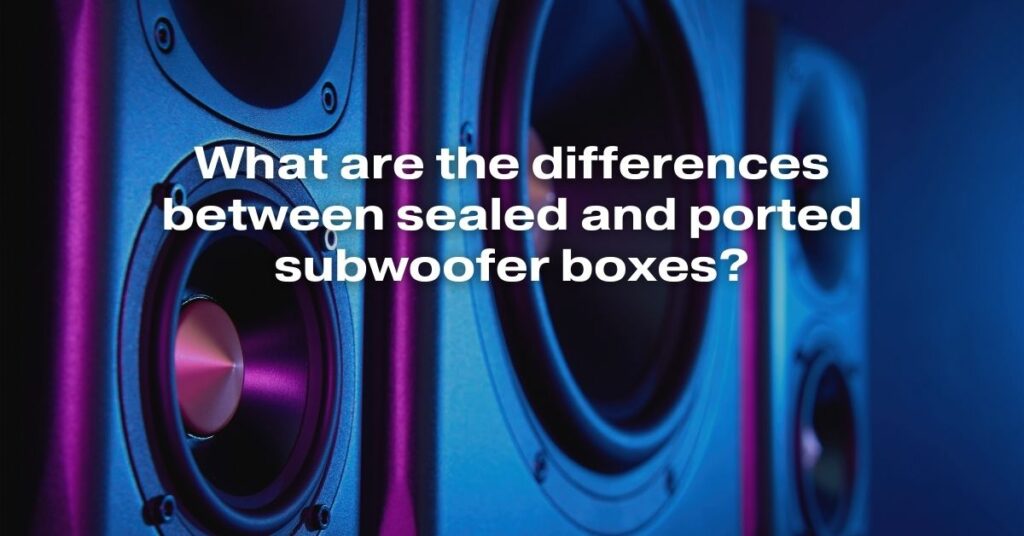When it comes to enhancing your audio experience with deep, rich bass, subwoofers are the go-to solution. However, the type of subwoofer box you choose can significantly impact the quality and characteristics of the bass you hear. Two primary types of subwoofer enclosures exist: sealed and ported. Understanding the differences between these two options is crucial for selecting the right subwoofer box for your specific needs and preferences.
Sealed Subwoofer Boxes: Tight and Accurate Bass
Sealed subwoofer boxes, also known as acoustic suspension enclosures, are characterized by their airtight construction. This design traps air inside the box, providing a controlled environment for the subwoofer to operate. As a result, sealed enclosures produce a tight, accurate bass response that is well-suited for genres like jazz, classical music, and acoustic performances.
Advantages of Sealed Subwoofer Boxes:
-
Tight, controlled bass: Sealed enclosures deliver precise, well-defined bass notes, ideal for music genres that demand accuracy and detail.
-
Compact Size: Sealed boxes are generally smaller than ported enclosures, making them more versatile for placement in various spaces.
-
Smoother Roll-off: Sealed subwoofers exhibit a gradual decline in bass output as the frequency decreases, resulting in a smoother, more natural sound.
Disadvantages of Sealed Subwoofer Boxes:
-
Lower Efficiency: Sealed enclosures require more power to achieve the same volume levels as ported boxes.
-
Limited Low-Frequency Extension: Sealed subwoofers may not produce the deepest bass frequencies, particularly at lower volumes.
Ported Subwoofer Boxes: Loud and Booming Bass
Ported subwoofer boxes, also known as bass-reflex enclosures, feature a vent or port that allows air to move in and out of the box. This design enhances the efficiency of the subwoofer, enabling it to produce louder, more powerful bass. Ported enclosures are often preferred for genres like hip-hop, electronic music, and rock, where deep, booming bass is desired.
Advantages of Ported Subwoofer Boxes:
-
Increased Efficiency: Ported enclosures are more efficient than sealed boxes, producing louder bass with less power.
-
Extended Low-Frequency Response: Ported subwoofers can reach lower bass frequencies, delivering a deeper, more impactful sound.
-
Higher Output: Ported boxes generally produce a higher overall volume level compared to sealed enclosures.
Disadvantages of Ported Subwoofer Boxes:
-
Less Accurate Bass: Ported enclosures may sacrifice some accuracy in favor of increased volume and low-frequency extension.
-
Larger Size: Ported boxes tend to be larger than sealed enclosures, requiring more space for installation.
-
Potential for Port Noise: If not properly designed, ported enclosures can exhibit port noise, which is a chuffing or distortion sound at high volumes.
Making the Right Choice: Sealed vs. Ported
The decision between a sealed and ported subwoofer box ultimately depends on your individual preferences and the type of music you enjoy. If you prioritize tight, accurate bass and a compact enclosure, a sealed subwoofer box is a suitable choice. On the other hand, if you crave deep, booming bass and maximum volume, a ported subwoofer box is likely a better fit.
Additional Considerations:
-
Subwoofer Size: The size of the subwoofer should be matched to the enclosure type. Larger subwoofers typically perform better in ported boxes, while smaller subwoofers are often well-suited for sealed enclosures.
-
Vehicle Size: If installing a subwoofer in a car, consider the available space. Sealed boxes are generally more compact and easier to fit in smaller vehicles.
-
Personal Preference: Ultimately, the choice between sealed and ported subwoofer boxes comes down to personal preference. Experiment with both types to determine which sound signature best suits your taste.
Remember, there is no definitive “better” option between sealed and ported subwoofer boxes. Each type offers unique advantages and drawbacks, and the best choice depends on your specific needs and preferences. By understanding the key differences between these enclosure designs, you can make an informed decision and enhance your listening experience with the perfect bass for your music.

